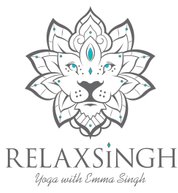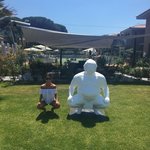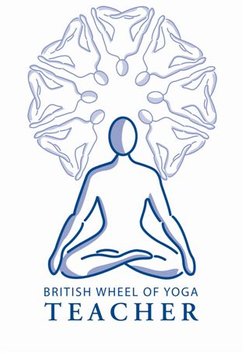"For the forest to be green, each tree has to be green" - Alistair Shearer
ABOUT ME
Hi, I'm Emma Singh, a forever student and practicing yogi, and the founder of 'Relaxsingh' yoga. I found yoga not long after I was diagnosed with a heart condition, and having never 'exercised' in my life, came to the realisation that yoga could be the perfect, gentle way to look after my health and wellbeing. I soon discovered that there is so much more to yoga, and am therefore strangely grateful for the diagnosis that led me here. Having now practiced yoga for a number of years, I made the decision to train with the British Wheel of Yoga* to share my love of yoga with others. My aim is to teach with passion, and I hope to inspire, motivate, enhance, challenge, and improve your practice.
Being from a mixed race background, I feel fortunate enough to have been exposed to different people, places, and perspectives. Yoga is India's gift to the world; pre dating both Hinduism and Buddhism, and handed down verbally from teacher to pupil for hundreds of years. Fortunately, while yoga has its roots in Indian thought, its content is universal because it is about the means by which we can make the changes that we desire to make in our lives. Thus, continuing the journey, your universal path to wholeness can be found here.
Relaxsingh yoga incorporates the powerful sequences of the Ashtanga Vinyasa, along with gentler restorative features of Yin, from a foundation of Hatha- designed to be accessible for you. Hatha yoga is a stairway, which leads to the higher teachings of Raja Yoga, the yoga of the mind. Overall, these practices aim to work to purify and strengthen the physical body, which in turn affects the mind.
ABOUT YOGA
Yoga attempts to create a place in which we are always present, really present- in every action, and in every moment. The Sanskrit word 'yoga' means concentration, but it can also be translated as union. Although it may seem possible for body, breath and mind to work independently of one another, the purpose of yoga is to unify their actions, leading us to positive changes in all aspects of our lives.
Body
Yoga is a balanced use of muscles to awaken and re-educate the nervous system, with a focus on mobilising the joints. Yoga helps us to build strength by actively engaging our muscles to keep us in a pose, and by using our core to support us. It's also a brilliant tool for opening up and gaining flexibility, as regular yoga practice limbers us up and helps us tap into our own flexibility.
As Peter Blackaby explains, in order to survive successfully in a changing world, our bodies learn to habituate certain activities. Anything we do repetitively will almost inevitably become habituated, and unfortunately this can include both appropriate and non-appropriate muscular patterns. We can therefore subconsciously impose tensions on our bodies. Yoga can be a wonderful way of addressing such habitual tension, and essential categories of movement for the body in the modern world, such as flexion, side bending, balancing and rotation.
In yoga, we use dynamic movements in line with the breath, to explore the body in an essential step towards improving inefficiency in posture. This can aid the flow of vital energy through the body, while we find rhythm of combined breath and movement.
Breath
The breath is the intelligence of the body, and yoga is as much a practice involving breath as it is involving the body. Normally we are not aware of our breathing, it is an automatic process and we do it subconsciously. However, consciously directed breath supports and strengthens the coordination of breath and with our body and mind. When we slow down and take deep, full breaths, we can relax our parasympathetic nervous system, which alleviates anxiety and tension- in fact regulating our breath is the easiest way to change our mindset and emotional state. If we are in pain it shows in our breathing, and if we are distracted we lose control of our breathing; the breath is a fundamental link between the inner and outer body.
In order to explore the body, in line with the breath, in yoga we use simple breathing exercises such as making the inhalation as long as possible, or by making the exhale slightly longer than the inhale. By doing this we are able to observe whether it is the chest or the abdomen that expands and therefore where we are sending our breath. Using our breath efficiently can help us to go deeper into each posture, aiding our physical practice. It is only by bringing body, breath and mind into unison that we realise the true quality of an asana. Therefore, the state of our breath is extremely important.
Mind
The ultimate purpose of yoga is to settle the mind; "yoga chitta vritti niradha" - learning to restrain the fluctuations of the mind. As defined in the Yoga Sutra, yoga is the ability to direct the mind without distraction or interruption. It is also said in the Yoga Sutra that when first beginning a yoga practice, we will experience waves of clarity and cloudiness, which over time will result in less cloudiness and more clarity. Noticing this shift in the minds patterns of perception is a useful way for us to measure our progress through yoga practice.
Our brains take cues from our bodies, and vice versa- so when we work on our bodies in yoga, our brain gets a positive message that everything is fine. Further to this, as we practice focusing our attention inwardly, we are able to train the mind to remain calm even when the body is being challenged, as yoga is a way of training the mind to stay calm, happy and relaxed.
Overall, focusing on the body, and breath, can help to clear the mind. Relaxation is a fundamental aspect of yoga, and each session typically ends with a supine relaxation pose, shavasana- as when the body is stable, the breath regulated, and the mind clear of thoughts, we are ready to slip into shavasana effortlessly and truly enjoy the moment.
*Qualification and Training
I am proud to have completed 500 hours of training with the British Wheel of Yoga (BWY) via a 3 year Diploma Qualification (this is a Level 4 course Ofqual recognised and equivalent to a Foundation Degree). This is the highest level of yoga teacher training currently available in the UK. BWY teachers study in-depth aspects of yoga practice including asana, pranayama (working with the breath), anatomy and physiology, meditation and the philosophy of yoga. All BWY teachers are fully insured, first aid trained, and have met or exceeded the National Occupational Standard to teach yoga. Once trained all teachers must undertake Continuous Professional Development. The British Wheel of Yoga is the largest yoga membership organisation in the UK, committed to promoting a greater understanding of yoga and its safe practice through experience, education, study and training.
© Copyright. All Rights Reserved.



